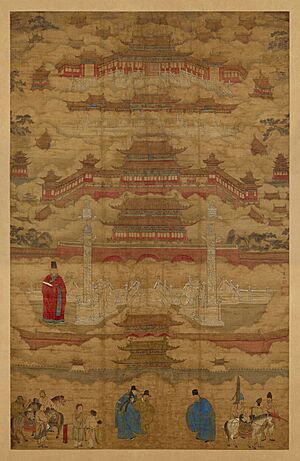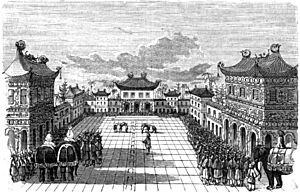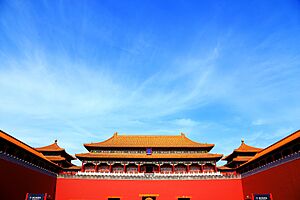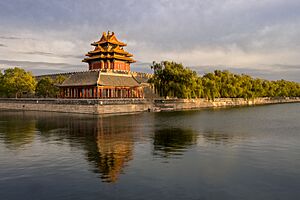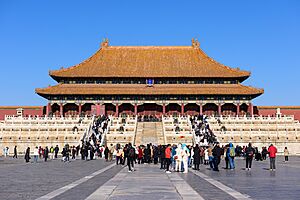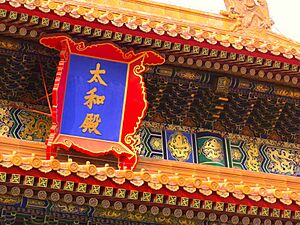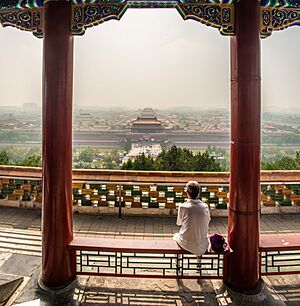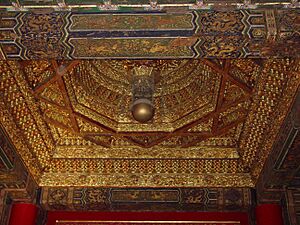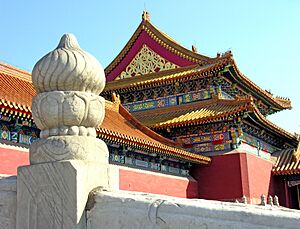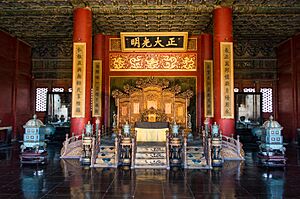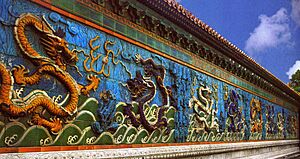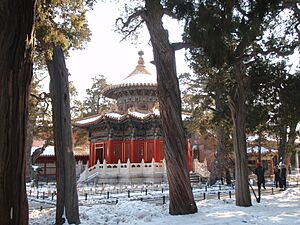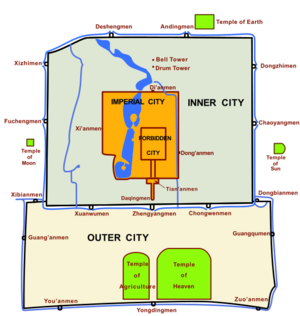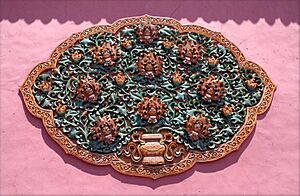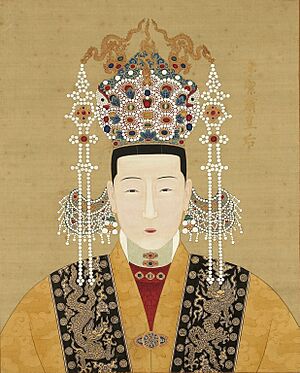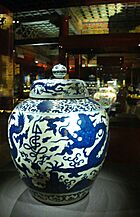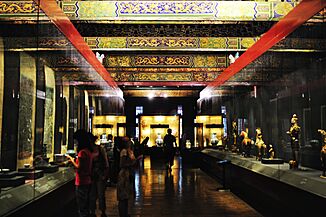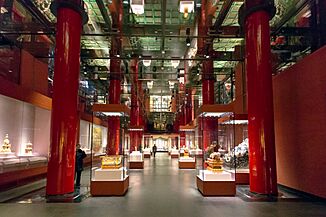Forbidden City facts for kids
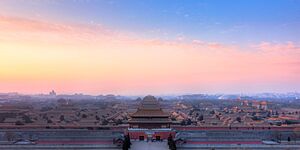
The Forbidden City viewed from Jingshan Hill
|
|
| Lua error in Module:Location_map at line 420: attempt to index field 'wikibase' (a nil value). | |
| Established | 1406– 1420 1925 (as public museum) |
|---|---|
| Location | 4 Jingshan Front St, Dongcheng District, Beijing, China |
| Type |
|
| Visitors | 16.7 million |
| Area | 72 hectares |
| Built | 1406–1420 (Ming dynasty) |
| Architect | Kuai Xiang |
| Architectural style(s) | Chinese architecture |
| UNESCO World Heritage Site | |
| Part of | Imperial Palaces of the Ming and Qing Dynasties in Beijing and Shenyang |
| Criteria | Cultural: i, ii, iii, iv |
| Inscription | 1987 (11th Session) |
| UNESCO World Heritage Site | |
| Part of | Beijing Central Axis |
| Criteria | Cultural: iii, iv |
| Inscription | 2024 (48th Session) |
| Forbidden City | |||||||||||||||||||||||||||||
|---|---|---|---|---|---|---|---|---|---|---|---|---|---|---|---|---|---|---|---|---|---|---|---|---|---|---|---|---|---|

"Forbidden City" in Chinese characters
|
|||||||||||||||||||||||||||||
| Chinese name | |||||||||||||||||||||||||||||
| Chinese | 紫禁城 | ||||||||||||||||||||||||||||
| Literal meaning | "Purple Forbidden City" | ||||||||||||||||||||||||||||
|
|||||||||||||||||||||||||||||
| Manchu name | |||||||||||||||||||||||||||||
| Manchu script | ᡩᠠᠪᡴᡡᡵᡳ ᡩᠣᡵᡤᡳ ᡥᠣᡨᠣᠨ |
||||||||||||||||||||||||||||
| Romanization | dabkūri dorgi hoton "Former Inner City" | ||||||||||||||||||||||||||||
The Forbidden City (Chinese: 紫禁城; pinyin: Zǐjìnchéng) is a huge palace complex in the heart of Beijing, China. For over 500 years, from 1420 to 1924, it was the home of 24 Ming and Qing emperors. It was also the main center of power in China. Today, the Palace Museum manages this amazing site, which is also a UNESCO World Heritage Site. The Forbidden City is known as the largest and best-preserved royal palace complex in the world.
Construction of the Forbidden City took place from 1406 to 1420. It served as the winter home for Chinese emperors and their families. It was also the place where important ceremonies and government decisions happened. Since 1925, the Forbidden City has been a public museum. It holds a vast collection of art and artifacts from the Ming and Qing dynasties. In 1987, it was recognized as a World Heritage Site.
The complex is said to have 9,999 rooms, but experts now say it has 8,886 rooms. It covers about 72 hectares (178 acres). This palace shows off the amazing wealth of the Chinese emperors. It also displays traditional Chinese architecture. Its design has influenced buildings across East Asia and beyond. UNESCO lists it as the largest collection of old wooden buildings still standing. Since 2012, the Forbidden City has welcomed around 14 million visitors each year. In 2019, it had over 19 million visitors.
Contents
What Does "Forbidden City" Mean?
The palace got its name because it was so huge and very few people could enter. Only the Emperor, his family, and special servants called Eunuchs were allowed inside. Anyone else who tried to enter without permission faced immediate execution. This is why it was called the "Forbidden City." The Chinese name, Zijincheng (Chinese: 紫禁城), means "Purple Forbidden City." This name first appeared officially in 1576.
The name "Zijincheng" has several layers of meaning. Zi, or "purple," refers to the North Star. Ancient Chinese people called it the Ziwei Star. In their traditional Chinese astrology, this star was the home of the Jade Emperor, a powerful god. The area around it, the Ziwei Enclosure, was the Jade Emperor's realm. The Forbidden City, as the home of the earthly emperor, was seen as its copy on Earth. Jin means "forbidden" or "taboo." Cheng originally meant a castle or fortress, but now it means "city" in Chinese.
Today, Chinese people often call the site Gugong (Chinese: 故宮), which means "Former Palace." The museum inside these buildings is known as the "Palace Museum" (Chinese: 故宮博物院; pinyin: Gùgōng Bówùyùan).
A Look at Its History
The construction of the Forbidden City began in 1406. This happened when Zhu Di, the son of the Hongwu Emperor, became the Yongle Emperor. He decided to move the capital from Nanjing to Beijing.
Building the palace took 14 years and over a million workers. They used special materials like large logs of Phoebe zhennan wood (Chinese: 楠木; pinyin: nánmù) from southwestern China's jungles. Huge blocks of marble came from quarries near Beijing. The floors of the main halls were made with "golden bricks" (Chinese: 金磚; pinyin: jīnzhuān), which were special paving bricks from Suzhou.
From 1420 to 1644, the Forbidden City was the main seat of the Ming dynasty. In April 1644, rebel forces led by Li Zicheng took over the city. He declared himself emperor but soon fled when armies of former Ming general Wu Sangui and Manchu forces arrived. As he left, he set fire to parts of the Forbidden City.
By October, the Manchus had taken control of northern China. A ceremony was held at the Forbidden City to announce the young Shunzhi Emperor as the new ruler of China under the Qing dynasty. The Qing rulers changed the names of some main buildings to focus on "harmony" instead of "supremacy." They also made the signs bilingual (Chinese and Manchu) and added shamanist traditions to the palace.
In 1860, during the Second Opium War, British and French forces occupied the Forbidden City until the war ended. In 1900, Empress Dowager Cixi had to flee the Forbidden City during the Boxer Rebellion. Forces from other countries then occupied it until the next year.
The Forbidden City was home to 24 emperors—14 from the Ming dynasty and 10 from the Qing dynasty. It stopped being China's political center in 1912 when Puyi, the last Emperor, gave up his throne. An agreement allowed Puyi to stay in the Inner Court, while the Outer Court was opened to the public. He was later asked to leave after a political event in 1924. The Palace Museum was then created in the Forbidden City in 1925.
In 1933, during the Japanese invasion of China, many national treasures from the Forbidden City had to be moved for safety. Some of the collection returned after World War II. However, another part was sent to Taiwan in 1948 by Chiang Kai-shek as his party was losing the Chinese Civil War. This smaller but valuable collection became the core of the National Palace Museum in Taipei in 1965.
After the People's Republic of China was founded in 1949, some parts of the Forbidden City were damaged. But during the Cultural Revolution, Premier Zhou Enlai sent an army group to protect the city, preventing further destruction.
In 1987, UNESCO declared the Forbidden City a World Heritage Site. It was recognized as the "Imperial Palace of the Ming and Qing Dynasties" because of its important role in Chinese architecture and culture.
In the early 21st century, the Palace Museum started a 16-year project to restore all buildings to how they looked before 1911. The goal was to open 76% of the palace to the public by 2020. As part of this project, several palaces and areas have been opened to visitors, including the Shoukang Palace in 2013 and the Cining Palace in 2015.
On November 5, 2024, it was 100 years since the last Emperor of China, Puyi, was asked to leave the palace by republican forces.
How the Forbidden City is Built

- – - This line roughly divides the Inner (north) and Outer (south) Courts.
| A. Meridian Gate B. Gate of Divine Might C. West Glorious Gate D. East Glorious Gate E. Corner towers F. Gate of Supreme Harmony G. Hall of Supreme Harmony |
H. Hall of Military Eminence J. Hall of Literary Glory K. Southern Three Places L. Palace of Heavenly Purity M. Imperial Garden N. Hall of Mental Cultivation O. Palace of Tranquil Longevity |
The Forbidden City is a rectangle, measuring 961 meters (3,153 feet) from north to south and 753 meters (2,470 feet) from east to west. It has 980 buildings that are still standing, with 8,886 "bays" or sections of rooms. It was designed to be the center of old Beijing. It is surrounded by a larger area called the Imperial City.
The central north-south line of the Forbidden City is still the main axis of Beijing today. This line goes south through Tiananmen Gate to Tiananmen Square. To the north, it goes through Jingshan Park to the Drum Tower and Bell Tower.
Walls and Gates
The Forbidden City is surrounded by a 7.9-meter (26-foot) high wall and a 6-meter (20-foot) deep, 52-meter (171-foot) wide moat. The walls are very strong, built with a packed earth core and covered with special bricks.
At each of the four corners of the wall, there are beautiful corner towers (E). These towers have complex roofs with 72 ridges. They are the most visible parts of the palace from outside the walls. Many old stories are told about them.
There is a gate on each side of the wall. The main entrance is the Meridian Gate (A) (Chinese: 午門; pinyin: Wǔmén) on the south side. To the north is the Gate of Divine Prowess (B) (Chinese: 神武門; pinyin: Shénwǔmén), which faces Jingshan Park. The east and west gates are the East Glorious Gate (D) (Chinese: 東華門; pinyin: Dōnghuámén) and the West Glorious Gate (C) (Chinese: 西華門; pinyin: Xīhuámén). All gates in the Forbidden City have nine-by-nine rows of golden door nails, except for the East Glorious Gate, which has eight.
The Meridian Gate has two parts that stick out, forming three sides of a square. It has five gateways. The central gateway is part of the Imperial Way, a stone path that runs through the center of the Forbidden City and Beijing. Only the emperor could use this path, except for the empress on her wedding day and successful students after the Imperial Examination.
The Outer Court: For Ceremonies
The Forbidden City is split into two main parts: the Outer Court (Chinese: 外朝; pinyin: Wàicháo) in the south and the Inner Court (Chinese: 内廷; pinyin: Nèitíng) in the north. The Outer Court was used for important ceremonies. The Inner Court was where the emperor and his family lived and handled daily government tasks. The most important buildings are all on the central north-south line.
After entering through the Meridian Gate, you come to a large square. A winding stream, the Inner Golden Water River, flows through it, crossed by five bridges. Beyond this square is the Gate of Supreme Harmony (F) (Chinese: 太和門; pinyin: Tàihémén). Behind this gate, three grand halls stand on a three-tiered white marble terrace. These are the Hall of Supreme Harmony (G), the Hall of Central Harmony, and the Hall of Preserving Harmony.
The Hall of Supreme Harmony (G) is the largest hall, rising about 30 meters (98 feet) above the square. It was the center of imperial power and is the biggest wooden building still standing in China. It is nine bays wide and five bays deep. The numbers 9 and 5 were special and linked to the emperor's power. The ceiling has a detailed caisson with a coiled dragon. In the Ming dynasty, the emperor met with officials here. In the Qing dynasty, it was used only for very special events like coronations and imperial weddings.
The Hall of Central Harmony is a smaller, square hall. The emperor used it to get ready and rest before and during ceremonies. Behind it, the Hall of Preserving Harmony was used for practicing ceremonies. It was also where the final part of the Imperial Examination took place. All three halls have imperial thrones, with the one in the Hall of Supreme Harmony being the largest and most detailed.
The stairs leading to these terraces have ceremonial ramps. These ramps are part of the Imperial Way and feature detailed carvings. The northern ramp, behind the Hall of Preserving Harmony, is carved from a single stone that weighs about 200 tons. It is the largest carving of its kind in China.
In the southwest and southeast of the Outer Court are the halls of Military Eminence (H) and Literary Glory (J). The Hall of Military Eminence was used for the emperor to meet with his ministers. The Hall of Literary Glory was used for special lectures by scholars and later became the office for important government officials.
The Inner Court: The Emperor's Home
The Inner Court is separated from the Outer Court by a long courtyard. This was the home of the Emperor and his family. In the Qing dynasty, the Emperor mostly lived and worked in the Inner Court. The Outer Court was only for formal ceremonies.
The Back Three Palaces
At the center of the Inner Court are three more halls (L):
- Palace of Heavenly Purity
- Hall of Union
- Palace of Earthly Tranquility
These halls are smaller than those in the Outer Court. They were the official homes of the Emperor and Empress. The Emperor, representing the heavens, lived in the Palace of Heavenly Purity. The Empress, representing the earth, lived in the Palace of Earthly Tranquility. The Hall of Union in between them symbolized harmony.
The Palace of Heavenly Purity was the Emperor's residence in the Ming dynasty. However, starting with the Yongzheng Emperor of the Qing dynasty, emperors lived in the smaller Hall of Mental Cultivation (N) to the west. The Palace of Heavenly Purity then became a hall where the Emperor met with people. Above the throne, there is a tablet that reads "Justice and Honour."
The Palace of Earthly Tranquility was the Empress's home in the Ming dynasty. In the Qing dynasty, parts of it were changed for Manchu religious ceremonies. From the Yongzheng Emperor's time, the Empress moved out. However, two rooms in this palace were kept for the Emperor's wedding night.
Between these two palaces is the Hall of Union. This square-shaped hall stores the 25 Imperial Seals of the Qing dynasty and other ceremonial items.
Behind these three halls is the Imperial Garden (M). It is a small but beautifully designed garden with many features. To the north of the garden is the Gate of Divine Might.
To the west is the Hall of Mental Cultivation (N). This palace became the main residence and office for emperors starting from Yongzheng. In the later years of the Qing dynasty, empresses dowager, like Cixi, held court here.
The northeastern part of the Inner Court has the Palace of Tranquil Longevity (O). The Qianlong Emperor built this complex for his retirement. It has its own "outer court," "inner court," gardens, and temples. A colorful Nine Dragons Screen marks its entrance.
Six Western and Six Eastern Palaces
To the west and east of the three main halls in the Inner Court are the Six Western Palaces and the Six Eastern Palaces. These palaces were where the emperor's consorts (wives and concubines) lived. There were six palaces on the west side and six on the east side. Their architecture is quite similar. Each palace has its own courtyards, main halls, and side halls. The main halls were in the middle, and the side halls were on the east and west. The front courtyard and its main hall were used for receiving guests, while the back courtyard and its main hall were living areas.
An imperial consort with a high rank was given a residence in the main part of a palace and managed it. Lower-ranking consorts lived in the side halls and were supervised by the higher-ranking ones.
These twelve palaces were where many Qing emperors were born and grew up. They were central to the daily life of the imperial family.
Some of the names of these palaces include: Western Six Palaces
- Palace of Eternal Longevity
- Hall of the Supreme Principle
- Palace of Eternal Spring
- Palace of Earthly Honour
- Palace of Gathering Elegance
- Palace of Universal Happiness
Eastern Six Palaces
- Palace of Great Benevolence
- Palace of Heavenly Grace
- Palace of Accumulated Purity
- Palace of Prolonging Happiness
- Palace of Great Brilliance
- Palace of Eternal Harmony
Cining Palace and Shoukang Palace
To the west of the Hall of Mental Cultivation (N) are Cining Palace (Palace of Compassion and Tranquility) and Shoukang Palace (Palace of Longevity and Good Health). These palaces were for the widowed wives of previous emperors. Emperors did not live with the wives of past emperors, so they had their own separate area. Cining Palace is larger and older than Shoukang Palace, which is to its west. South of Cining Palace is Cining Garden.
Religion in the Palace
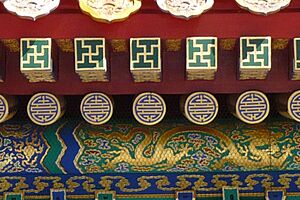
Religion was a big part of life for the imperial court. In the Qing dynasty, the Palace of Earthly Harmony was used for Manchu Shamanist ceremonies. The traditional Chinese Taoist religion also remained important. There were two Taoist shrines, one in the imperial garden and another in the Inner Court.
Buddhism was also very popular in the Qing dynasty palace. Many temples and shrines were found throughout the Inner Court, including those for Tibetan Buddhism. Buddhist symbols were also used in the decorations of many buildings. The Pavilion of the Rain of Flowers is one of the most important Buddhist sites. It held many Buddhist statues, symbols, and mandalas arranged in special ways.
What's Around the Forbidden City?
The palace complex is surrounded by many beautiful imperial gardens and temples. These include the 54-acre Zhongshan Park, the Imperial Ancestral Temple, the 171-acre Beihai Park, and the 57-acre Jingshan Park.
To the north of the Forbidden City is Jingshan Park, also called Prospect Hill. This is an artificial hill made from the soil dug out to build the moat and nearby lakes.
To the west is Zhongnanhai, a former royal garden with two connected lakes. Today, it is the main headquarters for the Chinese government. To the northwest is Beihai Park, another popular royal park centered on a lake.
South of the Forbidden City were two important shrines: the Imperial Ancestral Temple (Chinese: 太廟; pinyin: Tàimiào) and the Imperial Shrine of State (Chinese: 社稷壇; pinyin: Shèjìtán). Here, the Emperor honored his ancestors and the spirit of the nation. Today, these are public parks.
To the south, two similar gatehouses stand along the main axis. They are the Upright Gate and the more famous Tiananmen Gate. Tiananmen Gate has a portrait of Mao Zedong and two signs that say "Long Live the People's Republic of China" and "Long live the Great Unity of the World's Peoples." Tiananmen Gate connects the Forbidden City area with Tiananmen Square, a modern symbol of the Chinese state.
Today, new building around the Forbidden City is carefully controlled. In the past, some old buildings were torn down or rebuilt. Since 2000, the Beijing government has worked to move government and military groups out of historical buildings. They have also created a park around the remaining parts of the Imperial City wall. In 2004, new rules were made about building height and planning to protect the Imperial City area.
Architecture and Its Meanings

The design of the Forbidden City, from its overall layout to the smallest detail, was carefully planned. It reflected philosophical and religious ideas. Most importantly, it showed the great power of the Emperor. Here are some examples of these symbolic designs:
- Yellow is the Emperor's color. So, almost all roofs in the Forbidden City have yellow glazed tiles. There are only two exceptions. The library had black tiles because black was linked to water, which was thought to prevent fires. The Crown Prince's homes had green tiles because green was linked to wood and growth.
- The main halls of the Outer and Inner courts are arranged in groups of three. This shape represents Heaven. The homes in the Inner Court are arranged in groups of six. This shape represents the Earth.
- The sloping edges of building roofs are decorated with small statues. These statues are led by a man riding a phoenix and followed by an imperial dragon. The number of statues shows how important the building is. A small building might have three or five. The Hall of Supreme Harmony has ten, which was allowed for no other building in Imperial times.
Palace Museum Collections
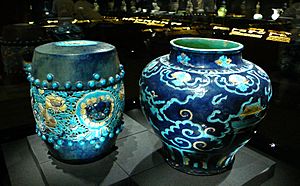
The collections of the Palace Museum come from the Qing imperial collection. They include paintings, ceramics, seals, sculptures, bronze items, and enamel objects. The latest count shows it has 1,862,690 pieces of art. The imperial libraries also held many rare books and historical documents.
From 1933, the threat of Japanese invasion made it necessary to move the most important parts of the Museum's collection. After World War II, some of this collection was returned. However, as the Communists were winning the Chinese Civil War, the Nationalist government decided to send the best parts of the collection to Taiwan. Of the 13,491 boxes of items moved, 2,972 boxes are now in the National Palace Museum in Taipei. More than 8,000 boxes returned to Beijing, but 2,221 boxes are still stored at the Nanjing Museum.
The Palace Museum has 340,000 pieces of ceramics and porcelain. This includes imperial collections from the Tang dynasty and the Song dynasty. It has almost 50,000 paintings, with over 400 dating from before the Yuan dynasty (1271–1368). Its bronze collection dates back to the early Shang dynasty. Of nearly 10,000 bronze pieces, about 1,600 have inscriptions from before the Qin dynasty (to 221 BC). A large part of the collection is ceremonial bronzeware from the imperial court.
The Palace Museum also has one of the world's largest collections of mechanical timepieces from the 18th and 19th centuries, with over 1,000 pieces. These include both Chinese-made and foreign-made items from countries like Britain, France, Switzerland, and Japan. Jade is very important in Chinese culture. The Museum's collection has about 30,000 jade pieces. The oldest pieces are from the Neolithic period. Besides art, a lot of the Museum's collection consists of items used by the imperial family and the palace in daily life. This collection helps us understand the daily life and ceremonies of the imperial era.
-
A blue and white porcelain vase with cloud and dragon designs from the Ming dynasty
Influence of the Forbidden City
The Forbidden City has greatly influenced how Chinese buildings are designed. It has also inspired many works of art.
See also
 In Spanish: Ciudad Prohibida para niños
In Spanish: Ciudad Prohibida para niños
- Forbidden City cats
- Imperial City of Huế


